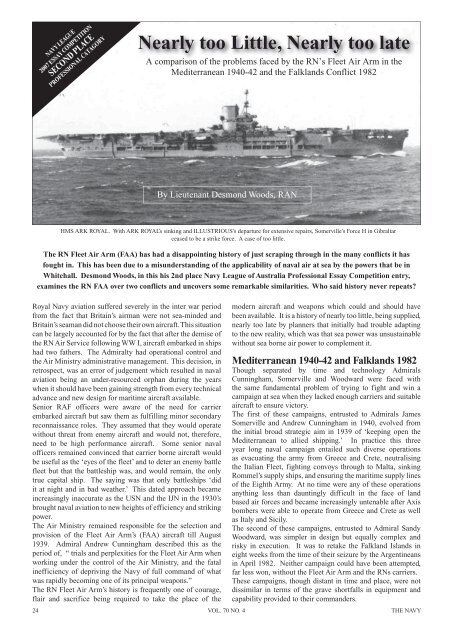The Navy Vol_70_No_4 Oct 2008 - Navy League of Australia
The Navy Vol_70_No_4 Oct 2008 - Navy League of Australia
The Navy Vol_70_No_4 Oct 2008 - Navy League of Australia
Create successful ePaper yourself
Turn your PDF publications into a flip-book with our unique Google optimized e-Paper software.
NAVY LEAGUE<br />
2007 ESSAY COMPETITION<br />
SECOND PLACE<br />
PROFESSIONAL CATAGORY<br />
Nearly too Little, Nearly too late<br />
A comparison <strong>of</strong> the problems faced by the RN’s Fleet Air Arm in the<br />
Mediterranean 1940-42 and the Falklands Conflict 1982<br />
By Lieutenant Desmond Woods, RAN<br />
HMS ARK ROYAL. With ARK ROYAL’s sinking and ILLUSTRIOUS’s departure for extensive repairs, Somerville’s Force H in Gibraltar<br />
ceased to be a strike force. A case <strong>of</strong> too little.<br />
<strong>The</strong> RN Fleet Air Arm (FAA) has had a disappointing history <strong>of</strong> just scraping through in the many conflicts it has<br />
fought in. This has been due to a misunderstanding <strong>of</strong> the applicability <strong>of</strong> naval air at sea by the powers that be in<br />
Whitehall. Desmond Woods, in this his 2nd place <strong>Navy</strong> <strong>League</strong> <strong>of</strong> <strong>Australia</strong> Pr<strong>of</strong>essional Essay Competition entry,<br />
examines the RN FAA over two conflicts and uncovers some remarkable similarities. Who said history never repeats?<br />
Royal <strong>Navy</strong> aviation suffered severely in the inter war period<br />
from the fact that Britain’s airman were not sea-minded and<br />
Britain’s seaman did not choose their own aircraft. This situation<br />
can be largely accounted for by the fact that after the demise <strong>of</strong><br />
the RN Air Service following WW I, aircraft embarked in ships<br />
had two fathers. <strong>The</strong> Admiralty had operational control and<br />
the Air Ministry administrative management. This decision, in<br />
retrospect, was an error <strong>of</strong> judgement which resulted in naval<br />
aviation being an under-resourced orphan during the years<br />
when it should have been gaining strength from every technical<br />
advance and new design for maritime aircraft available.<br />
Senior RAF <strong>of</strong>ficers were aware <strong>of</strong> the need for carrier<br />
embarked aircraft but saw them as fulfilling minor secondary<br />
reconnaissance roles. <strong>The</strong>y assumed that they would operate<br />
without threat from enemy aircraft and would not, therefore,<br />
need to be high performance aircraft. Some senior naval<br />
<strong>of</strong>ficers remained convinced that carrier borne aircraft would<br />
be useful as the ‘eyes <strong>of</strong> the fleet’ and to deter an enemy battle<br />
fleet but that the battleship was, and would remain, the only<br />
true capital ship. <strong>The</strong> saying was that only battleships ‘did<br />
it at night and in bad weather.’ This dated approach became<br />
increasingly inaccurate as the USN and the IJN in the 1930’s<br />
brought naval aviation to new heights <strong>of</strong> efficiency and striking<br />
power.<br />
<strong>The</strong> Air Ministry remained responsible for the selection and<br />
provision <strong>of</strong> the Fleet Air Arm’s (FAA) aircraft till August<br />
1939. Admiral Andrew Cunningham described this as the<br />
period <strong>of</strong>, “ trials and perplexities for the Fleet Air Arm when<br />
working under the control <strong>of</strong> the Air Ministry, and the fatal<br />
inefficiency <strong>of</strong> depriving the <strong>Navy</strong> <strong>of</strong> full command <strong>of</strong> what<br />
was rapidly becoming one <strong>of</strong> its principal weapons.’’<br />
<strong>The</strong> RN Fleet Air Arm’s history is frequently one <strong>of</strong> courage,<br />
flair and sacrifice being required to take the place <strong>of</strong> the<br />
modern aircraft and weapons which could and should have<br />
been available. It is a history <strong>of</strong> nearly too little, being supplied,<br />
nearly too late by planners that initially had trouble adapting<br />
to the new reality, which was that sea power was unsustainable<br />
without sea borne air power to complement it.<br />
Mediterranean 1940-42 and Falklands 1982<br />
Though separated by time and technology Admirals<br />
Cunningham, Somerville and Woodward were faced with<br />
the same fundamental problem <strong>of</strong> trying to fight and win a<br />
campaign at sea when they lacked enough carriers and suitable<br />
aircraft to ensure victory.<br />
<strong>The</strong> first <strong>of</strong> these campaigns, entrusted to Admirals James<br />
Somerville and Andrew Cunningham in 1940, evolved from<br />
the initial broad strategic aim in 1939 <strong>of</strong> ‘keeping open the<br />
Mediterranean to allied shipping.’ In practice this three<br />
year long naval campaign entailed such diverse operations<br />
as evacuating the army from Greece and Crete, neutralising<br />
the Italian Fleet, fighting convoys through to Malta, sinking<br />
Rommel’s supply ships, and ensuring the maritime supply lines<br />
<strong>of</strong> the Eighth Army. At no time were any <strong>of</strong> these operations<br />
anything less than dauntingly difficult in the face <strong>of</strong> land<br />
based air forces and became increasingly untenable after Axis<br />
bombers were able to operate from Greece and Crete as well<br />
as Italy and Sicily.<br />
<strong>The</strong> second <strong>of</strong> these campaigns, entrusted to Admiral Sandy<br />
Woodward, was simpler in design but equally complex and<br />
risky in execution. It was to retake the Falkland Islands in<br />
eight weeks from the time <strong>of</strong> their seizure by the Argentineans<br />
in April 1982. Neither campaign could have been attempted,<br />
far less won, without the Fleet Air Arm and the RNs carriers.<br />
<strong>The</strong>se campaigns, though distant in time and place, were not<br />
dissimilar in terms <strong>of</strong> the grave shortfalls in equipment and<br />
capability provided to their commanders.<br />
24 VOL. <strong>70</strong> NO. 4 THE NAVY

















